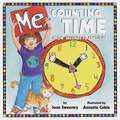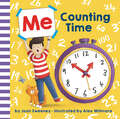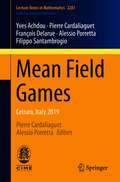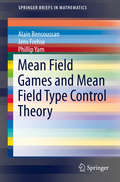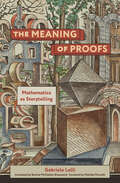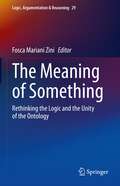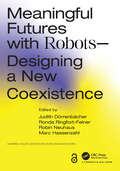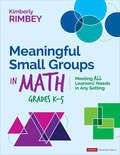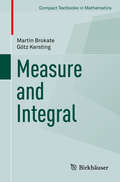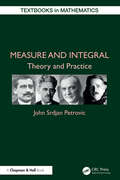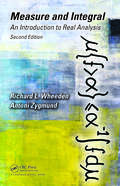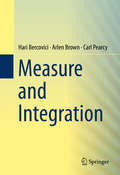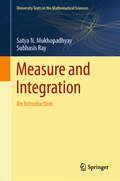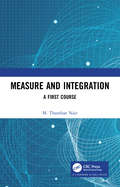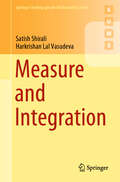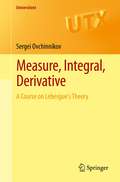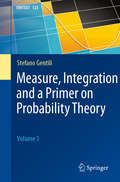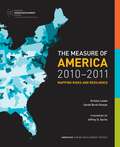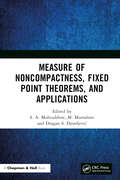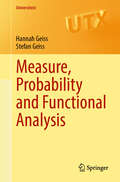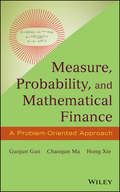- Table View
- List View
MCP Mathematics, Level E
by Dale Seymour Publications<p>MCP Mathematics promotes mathematical success for all students, especially those who struggle with their core math program. This trusted, targeted program uses a traditional drill and practice format with a predictable, easy-to-use lesson format. MCP Math is flexible and adaptable to fit a variety of intervention settings including after school, summer school, and additional math instruction during the regular school day. </p>
Me Counting Time: From Seconds to Centuries
by Joan SweeneyHow long is a second? Can you count a minute? What is a decade? How many years are in a century?Me Counting Time can show you! From a second to a minute to an hour to a day — and all the way to a millennium — this playful introduction to time helps children understand the many measurements of time and how they’re used in everyday life. Easy to read and easy to understand, Me Counting Time makes learning a fun time for every child.
Me Counting Time
by Joan SweeneyHow long is a minute? What is a decade? How many decades are in a century?Now with new illustrations by Alex Willmore, Me Counting Time is a playful introduction to the concept of time. When a young boy prepares for his seventh birthday and counts how many years old he is, he begins on an exploration of the many units of time that are a part of everyday life. Fun to read, easy to understand, and brimming with colorful illustrations, this title joins the other repackages in Joan Sweeney's popular Me...series--Me on the Map, Me and My Place in Space, Me and My Amazing Body, Me and My Family Tree, Me and the Measure of Things, and Me and My Senses.
Mean Field Games: Cetraro, Italy 2019 (Lecture Notes in Mathematics #2281)
by Yves Achdou Pierre Cardaliaguet François Delarue Alessio Porretta Filippo SantambrogioThis volume provides an introduction to the theory of Mean Field Games, suggested by J.-M. Lasry and P.-L. Lions in 2006 as a mean-field model for Nash equilibria in the strategic interaction of a large number of agents. Besides giving an accessible presentation of the main features of mean-field game theory, the volume offers an overview of recent developments which explore several important directions: from partial differential equations to stochastic analysis, from the calculus of variations to modeling and aspects related to numerical methods. Arising from the CIME Summer School "Mean Field Games" held in Cetraro in 2019, this book collects together lecture notes prepared by Y. Achdou (with M. Laurière), P. Cardaliaguet, F. Delarue, A. Porretta and F. Santambrogio.These notes will be valuable for researchers and advanced graduate students who wish to approach this theory and explore its connections with several different fields in mathematics.
Mean Field Games and Mean Field Type Control Theory
by Alain Bensoussan Jens Frehse Phillip YamMean field games and Mean field type control introduce new problems in Control Theory. The terminology "games" may be confusing. In fact they are control problems, in the sense that one is interested in a single decision maker, whom we can call the representative agent. However, these problems are not standard, since both the evolution of the state and the objective functional is influenced but terms which are not directly related to the state or the control of the decision maker. They are however, indirectly related to him, in the sense that they model a very large community of agents similar to the representative agent. All the agents behave similarly and impact the representative agent. However, because of the large number an aggregation effect takes place. The interesting consequence is that the impact of the community can be modeled by a mean field term, but when this is done, the problem is reduced to a control problem.
The Meaning of Proofs: Mathematics as Storytelling
by Gabriele LolliWhy mathematics is not merely formulaic: an argument that to write a mathematical proof is tantamount to inventing a story.In The Meaning of Proofs, mathematician Gabriele Lolli argues that to write a mathematical proof is tantamount to inventing a story. Lolli offers not instructions for how to write mathematical proofs, but a philosophical and poetic reflection on mathematical proofs as narrative. Mathematics, imprisoned within its symbols and images, Lolli writes, says nothing if its meaning is not narrated in a story. The minute mathematicians open their mouths to explain something—the meaning of x, how to find y—they are framing a narrative. Every proof is the story of an adventure, writes Lolli, a journey into an unknown land to open a new, connected route; once the road is open, we correct it, expand it. Just as fairy tales offer a narrative structure in which new characters can be inserted into recurring forms of the genre in original ways, in mathematics, each new abstract concept is the protagonist of a different theory supported by the general techniques of mathematical reasoning. In ancient Greece, there was more than an analogy between literature and mathematics, there was direct influence. Euclid&’s proofs have roots in poetry and rhetoric. Mathematics, Lolli asserts, is not the mere manipulation of formulas.
The Meaning of Something: Rethinking the Logic and the Unity of the Ontology (Logic, Argumentation & Reasoning #29)
by Fosca Mariani ZiniThis innovative volume investigates the meaning of ‘something’ in different recent philosophical traditions in order to rethink the logic and the unity of ontology, without forgetting to compare these views to earlier significative accounts in the history of philosophy. In fact, the revival of interest in “something” in the 19th and 20th centuries as well as in contemporary philosophy can easily be accounted for: it affords the possibility for asking the question: what is there? without engaging in predefined speculative assumptions The issue about “something” seems to avoid any naive approach to the question about what there is, so that it is treated in two main contemporary philosophical trends: “material ontology”, which aims at taking “inventory” of what there is, of everything that is; and “formal ontology”, which analyses the structural features of all there is, whatever it is. The volume advances cutting-edge debates on what is the first et the most general item in ontology, that is to say “something”, because the relevant features of the conceptual core of something are: non-nothingness, otherness. Something means that one being is different from others. The relationality belongs to something.: Therefore, the volume advances cutting-edge debates in phenomenology, analytic philosophy, formal and material ontology, traditional metaphysics.
The Meaning of the Concept of Probability in Application to Finite Sequences (Routledge Revivals)
by Hilary PutnamFirst published in 1990, this is a reissue of Professor Hilary Putnam’s dissertation thesis, written in 1951, which concerns itself with The Meaning of the Concept of Probability in Application to Finite Sequences and the problems of the deductive justification for induction. Written under the direction of Putnam’s mentor, Hans Reichenbach, the book considers Reichenbach’s idealization of very long finite sequences as infinite sequences and the bearing this has upon Reichenbach’s pragmatic vindication of induction.
Meaningful Futures with Robots: Designing a New Coexistence (Chapman & Hall/CRC Artificial Intelligence and Robotics Series)
by Judith Dörrenbächer Ronda Ringfort-Felner Robin Neuhaus Marc HassenzahlSoon, robots will leave the factories and make their way into living rooms, supermarkets, and care facilities. They will cooperate with humans in everyday life, taking on more than just practical tasks. How should they communicate with us? Do they need eyes, a screen, or arms? Should they resemble humans? Or may they enrich social situations precisely because they act so differently from humans? Meaningful Futures with Robots: Designing a New Coexistence provides insight into the opportunities and risks that arise from living with robots in the future, anchored in current research projects on everyday robotics. As well as generating ideas for robot developers and designers, it also critically discusses existing theories and methods for social robotics from different perspectives - ethical, design, artistical and technological – and presents new approaches to meaningful human-robot interaction design. Key Features: Provides insights into current research on robots from different disciplinary angles with a particular focus on a value-driven design. Includes contributions from designers, psychologists, engineers, philosophers, artists, and legal scholars, among others.
Meaningful Small Groups in Math, Grades K-5: Meeting All Learners’ Needs in Any Setting (Corwin Mathematics Series)
by Kimberly Ann RimbeyTarget the Math…Support the Students…Provide Access for All The need for focused small group math instruction has never been greater. Today’s education landscape is fraught with learning divides unlike anything we’ve faced in recent years. We need new ways of teaching students who have remarkably varying levels of understanding and vastly different needs. Meaningful Small Groups in Math, Grades K-5 offers practical guidance on how to meet the diverse needs of today’s students. Written for K-5 classroom teachers, math interventionists and instructional coaches, this user-friendly, accessible book provides guidance on the necessary components of small group instruction in math, trajectories for small-group instruction on specific concepts, and practical steps for getting started. Readers will find Checklists and templates for implementing small group, sample lessons in the major content domains Emphasis on flexible groups Intervention and extension ideas for differentiating learning A chapter devoted to developing small-group programs across a school or organization Small group instruction in mathematics has not been as well-developed as its counterpart in the reading world. In K-5 math classrooms, small-group instruction has typically been reduced to learning centers and rotation stations, with little emphasis on differentiated, small-group, teacher-facilitated learning. To meet the needs of today’s students, a more focused approach is needed.
Meaningful Small Groups in Math, Grades K-5: Meeting All Learners’ Needs in Any Setting (Corwin Mathematics Series)
by Kimberly Ann RimbeyTarget the Math…Support the Students…Provide Access for All The need for focused small group math instruction has never been greater. Today’s education landscape is fraught with learning divides unlike anything we’ve faced in recent years. We need new ways of teaching students who have remarkably varying levels of understanding and vastly different needs. Meaningful Small Groups in Math, Grades K-5 offers practical guidance on how to meet the diverse needs of today’s students. Written for K-5 classroom teachers, math interventionists and instructional coaches, this user-friendly, accessible book provides guidance on the necessary components of small group instruction in math, trajectories for small-group instruction on specific concepts, and practical steps for getting started. Readers will find Checklists and templates for implementing small group, sample lessons in the major content domains Emphasis on flexible groups Intervention and extension ideas for differentiating learning A chapter devoted to developing small-group programs across a school or organization Small group instruction in mathematics has not been as well-developed as its counterpart in the reading world. In K-5 math classrooms, small-group instruction has typically been reduced to learning centers and rotation stations, with little emphasis on differentiated, small-group, teacher-facilitated learning. To meet the needs of today’s students, a more focused approach is needed.
Measure and Integral
by Martin Brokate Götz KerstingThe Lebesgue integral is an essential tool in the fields of analysis and stochastics and for this reason, in many areas where mathematics is applied. This textbook is a concise, lecture-tested introduction to measure and integration theory. It addresses the important topics of this theory and presents additional results which establish connections to other areas of mathematics. The arrangement of the material should allow the adoption of this textbook in differently composed Bachelor programmes.
Measure and Integral: Theory and Practice (Textbooks in Mathematics)
by John Srdjan PetrovicThis accessible introduction to the topic covers the theory of measure and integral, as introduced by Lebesgue and developed in the first half of the 20th century. It leads naturally to Banach spaces of functions and linear operators acting on them.This material in Measure and Integral: Theory and Practice is typically covered in a graduate course and is almost always treated in an abstract way, with little or no motivation. The author employs a plethora of examples and exercises and strives to motivate every concept with its historical background. This textbook is accessible to a wider range of students, including at the undergraduate level.A major problem facing anyone teaching measure theory is how to combine the elementary approach (measure on the real line or in the plane) and the abstract measure theory. The author develops a theory of measure in the plane, then shows how to generalize these ideas to an abstract setting.The result is a textbook accessible to a wider range of students.The material requires a good understanding of topics often referred to as advanced calculus, such as Riemann integration on Euclidean spaces and series of functions. Also, a reader is expected to be proficient in the basics of set theory and point-set topology, preferably including metric spaces.
Measure and Integral: An Introduction to Real Analysis, Second Edition (Chapman & Hall/CRC Pure and Applied Mathematics)
by Richard L. WheedenNow considered a classic text on the topic, Measure and Integral: An Introduction to Real Analysis provides an introduction to real analysis by first developing the theory of measure and integration in the simple setting of Euclidean space, and then presenting a more general treatment based on abstract notions characterized by axioms and with less
Measure and Integration
by Hari Bercovici Arlen Brown Carl PearcyThis book covers the material of a oneyear course in real analysis. It includes an original axiomatic approachto Lebesgue integration which the authors have found to be effective in theclassroom. Each chapter contains numerous examples and an extensiveproblem set which expands considerably the breadth of the material covered inthe text. Hints are included for some of the more difficult problems.
Measure and Integration: An Introduction (University Texts in the Mathematical Sciences)
by Satya N. Mukhopadhyay Subhasis RayDesigned for senior undergraduate and graduate students in mathematics, this textbook offers a comprehensive exploration of measure theory and integration. It acts as a pivotal link bridging the Riemann integral and the Lebesgue integral, with a primary focus on tracing the evolution of measure and integration from their historical roots. A distinctive feature of the book is meticulous guidance, providing a step-by-step journey through the subject matter, thus rendering complex concepts more accessible to beginners. A fundamental grasp of differential and integral calculus, as well as Riemann integration, is recommended to ensure a smoother comprehension of the material. This textbook comprises 10 well-structured chapters, each thoughtfully organized to lead students from fundamental principles to advanced complexities. Beginning with the establishment of Lebesgue’s measure on the real line and an introduction to measurable functions, the book then delves into exploring the cardinalities of various set classes. As readers progress, the subtleties of the Lebesgue integral emerge, showcasing its generalization of the Riemann integral and its unique characteristics in higher dimensions. One of the book’s distinctive aspects is its indepth comparison of the Lebesgue integral, improper Riemann integral, and Newton integral, shedding light on their distinct qualities and relative independence. Subsequent chapters delve into the realm of general measures, Lebesgue-Stieltje's measure, Hausdorff ’s measure, and the concept of measure and integration in product spaces. Furthermore, the book delves into function spaces, such as 𝘓𝘱 spaces, and navigates the intricacies of signed and complex measures, providing students with a comprehensive foundation in this vital area of mathematics.
Measure and Integration: A First Course
by M Thamban NairThis concise text is intended as an introductory course in measure and integration. It covers essentials of the subject, providing ample motivation for new concepts and theorems in the form of discussion and remarks, and with many worked-out examples. The novelty of Measure and Integration: A First Course is in its style of exposition of the standard material in a student-friendly manner. New concepts are introduced progressively from less abstract to more abstract so that the subject is felt on solid footing. The book starts with a review of Riemann integration as a motivation for the necessity of introducing the concepts of measure and integration in a general setting. Then the text slowly evolves from the concept of an outer measure of subsets of the set of real line to the concept of Lebesgue measurable sets and Lebesgue measure, and then to the concept of a measure, measurable function, and integration in a more general setting. Again, integration is first introduced with non-negative functions, and then progressively with real and complex-valued functions. A chapter on Fourier transform is introduced only to make the reader realize the importance of the subject to another area of analysis that is essential for the study of advanced courses on partial differential equations. Key Features Numerous examples are worked out in detail. Lebesgue measurability is introduced only after convincing the reader of its necessity. Integrals of a non-negative measurable function is defined after motivating its existence as limits of integrals of simple measurable functions. Several inquisitive questions and important conclusions are displayed prominently. A good number of problems with liberal hints is provided at the end of each chapter. The book is so designed that it can be used as a text for a one-semester course during the first year of a master's program in mathematics or at the senior undergraduate level. About the Author M. Thamban Nair is a professor of mathematics at the Indian Institute of Technology Madras, Chennai, India. He was a post-doctoral fellow at the University of Grenoble, France through a French government scholarship, and also held visiting positions at Australian National University, Canberra, University of Kaiserslautern, Germany, University of St-Etienne, France, and Sun Yat-sen University, Guangzhou, China. The broad area of Prof. Nair’s research is in functional analysis and operator equations, more specifically, in the operator theoretic aspects of inverse and ill-posed problems. Prof. Nair has published more than 70 research papers in nationally and internationally reputed journals in the areas of spectral approximations, operator equations, and inverse and ill-posed problems. He is also the author of three books: Functional Analysis: A First Course (PHI-Learning, New Delhi), Linear Operator Equations: Approximation and Regularization (World Scientific, Singapore), and Calculus of One Variable (Ane Books Pvt. Ltd, New Delhi), and he is also co-author of Linear Algebra (Springer, New York).
Measure and Integration (Springer Undergraduate Mathematics Series)
by Satish Shirali Harkrishan Lal VasudevaThis textbook provides a thorough introduction to measure and integration theory, fundamental topics of advanced mathematical analysis.Proceeding at a leisurely, student-friendly pace, the authors begin by recalling elementary notions of real analysis before proceeding to measure theory and Lebesgue integration. Further chapters cover Fourier series, differentiation, modes of convergence, and product measures. Noteworthy topics discussed in the text include Lp spaces, the Radon–Nikodým Theorem, signed measures, the Riesz Representation Theorem, and the Tonelli and Fubini Theorems.This textbook, based on extensive teaching experience, is written for senior undergraduate and beginning graduate students in mathematics. With each topic carefully motivated and hints to more than 300 exercises, it is the ideal companion for self-study or use alongside lecture courses.
Measure, Integral, Derivative
by Sergei OvchinnikovThis classroom-tested text is intended for a one-semester course in Lebesgue's theory. With over 180 exercises, the text takes an elementary approach, making it easily accessible to both upper-undergraduate- and lower-graduate-level students. The three main topics presented are measure, integration, and differentiation, and the only prerequisite is a course in elementary real analysis. In order to keep the book self-contained, an introductory chapter is included with the intent to fill the gap between what the student may have learned before and what is required to fully understand the consequent text. Proofs of difficult results, such as the differentiability property of functions of bounded variations, are dissected into small steps in order to be accessible to students. With the exception of a few simple statements, all results are proven in the text. The presentation is elementary, where σ-algebras are not used in the text on measure theory and Dini's derivatives are not used in the chapter on differentiation. However, all the main results of Lebesgue's theory are found in the book.
Measure, Integration and a Primer on Probability Theory: Volume 1 (UNITEXT #125)
by Stefano GentiliThe text contains detailed and complete proofs and includes instructive historical introductions to key chapters. These serve to illustrate the hurdles faced by the scholars that developed the theory, and allow the novice to approach the subject from a wider angle, thus appreciating the human side of major figures in Mathematics. The style in which topics are addressed, albeit informal, always maintains a rigorous character. The attention placed in the careful layout of the logical steps of proofs, the abundant examples and the supplementary remarks disseminated throughout all contribute to render the reading pleasant and facilitate the learning process. The exposition is particularly suitable for students of Mathematics, Physics, Engineering and Statistics, besides providing the foundation essential for the study of Probability Theory and many branches of Applied Mathematics, including the Analysis of Financial Markets and other areas of Financial Engineering.
The Measure of America, 2010-2011: Mapping Risks and Resilience (Social Science Research Council #9)
by Kristen Lewis Sarah Burd-SharpsThe Measure of America, 2010-2011, is the definitive report on the overall well-being of all Americans. How are Americans doing—compared to one another and compared to the rest of the world? This important, easy-to-understand guide will provide all of the essential information on the current state of America.This fully illustrated report, with over 130 color images, is based on the groundbreaking American Human Development Index, which provides a single measure of the well-being for all Americans, disaggregated by state and congressional district, as well as by race, gender, and ethnicity. The Index rankings of the 50 states and 435 congressional districts reveal huge disparities in the health, education, and living standards of different groups. For example, overall, Connecticut ranked first among states on the 2008-2009 Index, and Mississippi ranked last, suggesting that there is a 30-year gap in human development between the two states. Further, among congressional districts, New York’s 14th District, in Manhattan, ranked first, and California’s 20th District, near Fresno, ranked last. The average resident of New York’s 14th District earned over three times as much as the average resident of California’s 20th District, lived over four years longer, and was ten times as likely to have a college degree.The second in the American Human Development Report series, the 2010-2011 edition features a completely updated Index, new findings on the well-being of different racial and ethnic groups from state to state, and a closer look at disparities within major metro areas. It also shines a spotlight on threats to progress and opportunity for some Americans as well as highlighting tested approaches to fosteringresilience among different groups.Using a revelatory framework for explaining the very nature of humanprogress, this report can be used not only as a way to measure America but also to build upon past policy successes, protect the progress made over the last half century from new risks, and create an infrastructure of opportunity that can serve a new generation of Americans. Beautifully illustrated with stunning four-color graphics that allow for a quick visual understanding of often complex but important issues, The Measure of America is essential reading for all Americans, especially for social scientists, policy makers, and pundits who want to understand where Americans stand today.
The Measure of Economies: Measuring Productivity in an Age of Technological Change
by Marshall B. Reinsdorf Louise SheinerInnovative new approaches for improving GDP measurement to better gauge economic productivity. Official measures of gross domestic product (GDP) indicate that productivity growth has declined in the United States over the last two decades. This has led to calls for policy changes from pro-business tax reform to stronger antitrust measures. But are our twentieth-century economic methods actually measuring our twenty-first-century productivity? The Measure of Economies offers a synthesis of the state of knowledge in productivity measurement at a time when many question the accuracy and scope of GDP. With chapters authored by leading economic experts on topics such as the digital economy, health care, and the environment, it highlights the inadequacies of current practices and discusses cutting-edge alternatives. Pragmatic and forward-facing, The Measure of Economies is an essential resource not only for social scientists, but also for policymakers and business leaders seeking to understand the complexities of economic growth in a time of rapidly evolving technology.
Measure of Noncompactness, Fixed Point Theorems, and Applications
by S. A. Mohiuddine M. Mursaleen Dragan S. DjordjevićThe theory of the measure of noncompactness has proved its significance in various contexts, particularly in the study of fixed point theory, differential equations, functional equations, integral and integrodifferential equations, optimization, and others. This edited volume presents the recent developments in the theory of the measure of noncompactness and its applications in pure and applied mathematics. It discusses important topics such as measures of noncompactness in the space of regulated functions, application in nonlinear infinite systems of fractional differential equations, and coupled fixed point theorem.Key Highlights: Explains numerical solution of functional integral equation through coupled fixed point theorem, measure of noncompactness and iterative algorithm Showcases applications of the measure of noncompactness and Petryshyn’s fixed point theorem functional integral equations in Banach algebra Explores the existence of solutions of the implicit fractional integral equation via extension of the Darbo’s fixed point theorem Discusses best proximity point results using measure of noncompactness and its applications Includes solvability of some fractional differential equations in the holder space and their numerical treatment via measures of noncompactness This reference work is for scholars and academic researchers in pure and applied mathematics.
Measure, Probability and Functional Analysis (Universitext)
by Hannah Geiss Stefan GeissThis textbook offers a self-contained introduction to probability, covering all topics required for further study in stochastic processes and stochastic analysis, as well as some advanced topics at the interface between probability and functional analysis. The initial chapters provide a rigorous introduction to measure theory, with a special focus on probability spaces. Next, Lebesgue integration theory is developed in full detail covering the main methods and statements, followed by the important limit theorems of probability. Advanced limit theorems, such as the Berry-Esseen Theorem and Stein’s method, are included. The final part of the book explores interactions between probability and functional analysis. It includes an introduction to Banach function spaces, such as Lorentz and Orlicz spaces, and to random variables with values in Banach spaces. The Itô–Nisio Theorem, the Strong Law of Large Numbers in Banach spaces, and the Bochner, Pettis, and Dunford integrals are presented. As an application, Brownian motion is rigorously constructed and investigated using Banach function space methods. Based on courses taught by the authors, this book can serve as the main text for a graduate-level course on probability, and each chapter contains a collection of exercises. The unique combination of probability and functional analysis, as well as the advanced and original topics included, will also appeal to researchers working in probability and related fields.
Measure, Probability, and Mathematical Finance
by Hong Xie Chaoqun Ma Guojun GanAn introduction to the mathematical theory and financial models developed and used on Wall StreetProviding both a theoretical and practical approach to the underlying mathematical theory behind financial models, Measure, Probability, and Mathematical Finance: A Problem-Oriented Approach presents important concepts and results in measure theory, probability theory, stochastic processes, and stochastic calculus. Measure theory is indispensable to the rigorous development of probability theory and is also necessary to properly address martingale measures, the change of numeraire theory, and LIBOR market models. In addition, probability theory is presented to facilitate the development of stochastic processes, including martingales and Brownian motions, while stochastic processes and stochastic calculus are discussed to model asset prices and develop derivative pricing models.The authors promote a problem-solving approach when applying mathematics in real-world situations, and readers are encouraged to address theorems and problems with mathematical rigor. In addition, Measure, Probability, and Mathematical Finance features:A comprehensive list of concepts and theorems from measure theory, probability theory, stochastic processes, and stochastic calculusOver 500 problems with hints and select solutions to reinforce basic concepts and important theoremsClassic derivative pricing models in mathematical finance that have been developed and published since the seminal work of Black and Scholes Measure, Probability, and Mathematical Finance: A Problem-Oriented Approach is an ideal textbook for introductory quantitative courses in business, economics, and mathematical finance at the upper-undergraduate and graduate levels. The book is also a useful reference for readers who need to build their mathematical skills in order to better understand the mathematical theory of derivative pricing models.

